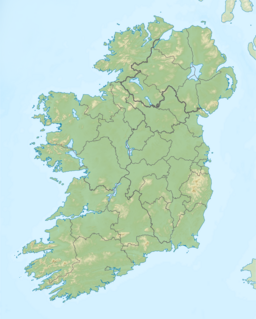| Lough Currane | |
|---|---|
| Loch Luíoch (Irish) | |
 | |
| Location | County Kerry, Ireland |
| Coordinates | 51°50′N 10°08′W / 51.83°N 10.13°W |
| Primary inflows | Capall River, Cummeragh River |
| Primary outflows | Currane River to Ballinskelligs Bay[1] |
| Basin countries | Ireland |
| Surface area | 10 km2 (3.9 sq mi) |
| Surface elevation | 5.8 m (19 ft) |
| Islands | Church Island, Rough Island, Rough Island Little, Gull Island, Rabbit Island, Oven Island, Grass Island, Carrigrower Rock, Cummeragh Island, Darby's Island, Morgan Island, Commane's Islands, Holly Island, Quarter Gannet Island, Daniel's Island, Whort Island, Fur Island, Otter Island, Arbutus Island, Tub Island Large, Tub Island Little, Horse Island, Reenaskinna Islands |
| Settlements | Raheen, Waterville |
Lough Currane (Irish: Loch Luíoch),[2] also called Lough Leeagh, is a lake in County Kerry, Ireland. Waterville lies on its western bank, close to the Atlantic Ocean, it empties into Ballinskelligs Bay. The numerous townlands which lie on its southern bank, including Cappamore, Eightercua and Gortnamackanee, are collectively known as Glenmore. It covers an area of 2,500 acres (10 km2) and is 3.5 miles (5.6 km) long and 2 miles (3.2 km) at the widest point. The lake is notable for the Early Medieval monastery on Church Island.[3] It is associated with had the St. Finan Cam, who inhabited the island c. 7th century. To the south of the lake is Inis Uasal (Noble Island), an island dedicated to St. Finan. The Annals of Inisfallen mention that Amchad, the "anchorite of God" was buried on the island in 1058.[4]
- ^ "An Assessment of Juvenile Salmonid Abundance and Distribution in the Currane Catchment 2014 & Comparison with Previous Surveys". Inland Fisheries Ireland. June 2014. Retrieved 2 June 2021.
- ^ "Loch Luíoch/Lough Currane". Placenames Database of Ireland (logainm.ie). Government of Ireland - Department of Arts, Heritage and the Gaeltacht and Dublin City University. Retrieved 10 March 2020.
- ^ Journal of the Royal Society of Antiquaries of Ireland, Volume 5. The Society. 1867. p. 28.
- ^ Carver, Martin (2006). The cross goes north: processes of conversion in northern Europe, AD 300-1300. Boydell Press. p. 134. ISBN 1-84383-125-2.
